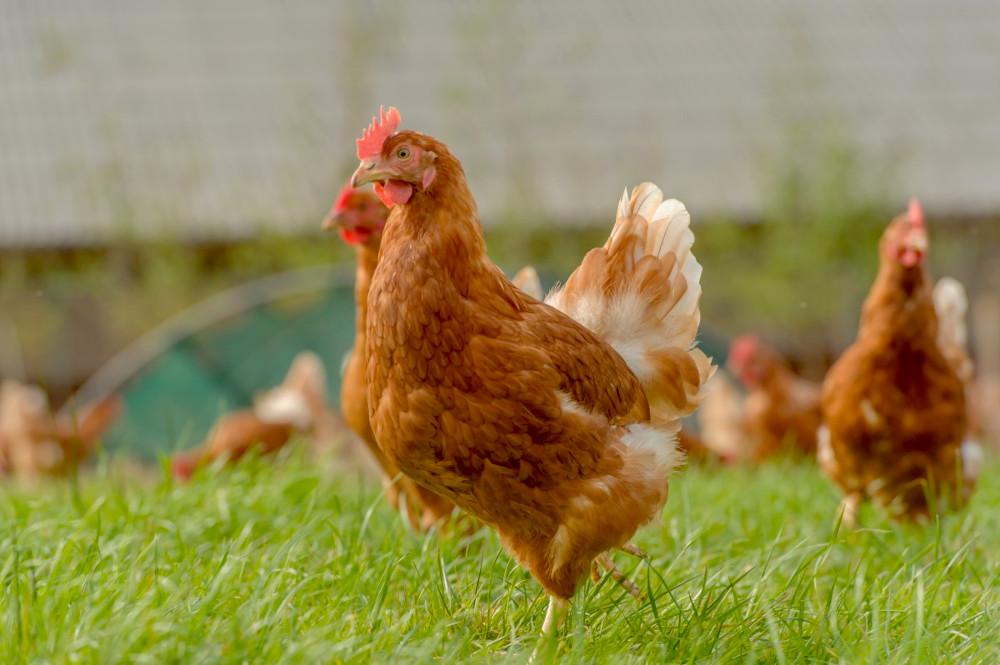
Hens’ use of the outdoor range area in free-range housing systems is dependent on multiple factors. These factors include the condition and design of the range area; rearing and internal housing conditions; ease of access to the range area; shelter and shade provision; presence of enrichment; flock size and stocking density; ambient weather (including wind speed, rainfall, and temperature); and the time of day when provided access to the range.
Outdoor openings
Hens when provided the choice most often use the range in the morning and afternoons. So that birds may easily access the range there should be sufficient pop-holes (openings from the shed) that allow hens’ unimpeded access to the outdoors during throughout the day [2, 3].
Shade and shelter
One major cause of poor outdoor range use by hens is barren outdoor environments [2]. Hens are prey animals meaning they are naturally more fearful of aerial predators such as eagles and hawks. In natural environments hens will use trees and bush-like vegetation for safety. Therefore, it is important that any outdoor range area has sufficient cover (overhead and/or vertical structures) which are easily accessible from the shed to encourage and allow hens to feel safe while on the range. Ensuring protection from ground predators such as dogs and foxes by fencing the range area or using guardian animals is also important to reduce fear and stress and encourage ranging in hens [5]. Providing natural (e.g. trees and shrubs) or artificial (e.g. shade cloths) shade and shelter can also encourage hens to range while protecting them from the rain or hot weather [2, 4, 6, 7].
Vegetation and enrichment
The quality of the outdoor area also affects range use. Providing a complex and enriching range with palatable vegetation, trees, shrubs and tree trunks/logs is another way of improving the overall quality and attractiveness of the outdoor range for hens [6].
The provision of enrichment materials for hens also impacts their range use. Hens are naturally motivated to perform behaviours such as dustbathing and foraging. An outdoor range should provide suitable areas (e.g. sand pits) for dustbathing and other forms of enrichment such as hay bales, forages and palatable vegetation to encourage foraging and exploratory behaviours. Enriched outdoor ranges have been shown to encourage a larger number of hens onto the range compared to an outdoor area without enrichment [4].
Maintaining shade and shelter structures and regularly rotating range areas to maintain vegetation cover and insect availability can help ensure the range remains attractive for hens [6]. Some ways in which this can be done is by using mobile sheds which are moved or rotated between ranges or by allowing access to only part of the range at a time. Rotating the range area can also help reduce the parasite burden and as a result minimise the risk of disease in hens [8]. Ensuring that the outdoor range area is not overly muddy or full of puddles and fenced off from any open water sources is also critical for minimising the risk of disease.
Space allowance
A lower stocking density and flock size has been shown to increase the amount of time hens will spend on the range [9–10]. Lower stocking densities may allow hens to move around and access pop-hole openings to outdoor range more easily than in higher stocking densities. In addition to this lower flock sizes have been associated with increased range use, suggesting range use may also be influenced by the social dynamics of a flock.
Pullet rearing and training
Pullets (young sexually immature hens) are usually reared on specialised rearing farm before they are transferred to their layer hen housing system. Pullets without outdoor access during rearing are often less adaptable and may take longer (several weeks) after transfer to become accustomed to using the outdoor range area in comparison to pullets which have been reared in a similar environment to their free-range layer hen housing system [1]. To learn more about the importance of pullet training and rearing, click here.
Free-range layer hen housing systems can provide hens with additional opportunities to perform naturally motivated behaviours and encourage positive experiences. If the outdoor area is attractive and provides hens with sufficient protection, hens will access it. Research suggests that 80% of the hens will use the range at some point in the day with at least half of those hens using it for 80% of the time available to them [4]. It is therefore essential that these systems are providing an attractive outdoor range area for hens, which also protects them from predators while minimising the risk of disease.
References
[1] Campbell et al [2018] Early enrichment in free-range laying hens: effects on ranging behaviour, welfare and response to stressors. Animals 12:575-584.
[2] Gilani et al [2014] Factors affecting ranging behaviour in young and adult laying hens. British Poultry Science 55:127-135.
[3] Pettersson IC et al [2016] Factors affecting ranging behaviour in commercial free-range hens. World’s Poultry Science Journal 72:137-149.
[4] Nagle TAD, Glatz PC [2012] Free range hens use the range more when the outdoor environment is enriched. Asian-Australasian Journal of Animal Science 25:584–591.
[5] Bestman M, Bikker-Ouwejean J [2020] Predation in organic and free-range egg production. Animals 10:177.
[6] de Koning C et al [2018] Determination of range enrichment for improved hen welfare on commercial fixed-range free-range layer farms. Animal Product Science 59:1336-1348.
[7] Pettersson IC et al [2017] Provision of a resource package reduces feather pecking and improves ranging distribution on free-range layer farms. Applied Animal Behaviour Science 195:60-66.
[8] Maurer V et al [2013] Effects of paddock management on vegetation, nutrient accumulation, and internal parasites in laying hens. Journal of Applied Poultry Research 22:334-343.
[9] Gilani et al [2014] Factors affecting ranging behaviour in young and adult laying hens. British Poultry Science 55:127-135.
[10] Campbell DLM, Hinch GN, Dyall TR et al (2017) Outdoor stocking density in free-range laying hens: radio-emergency identification of impacts on range use. Animal 11(1):121-130.
